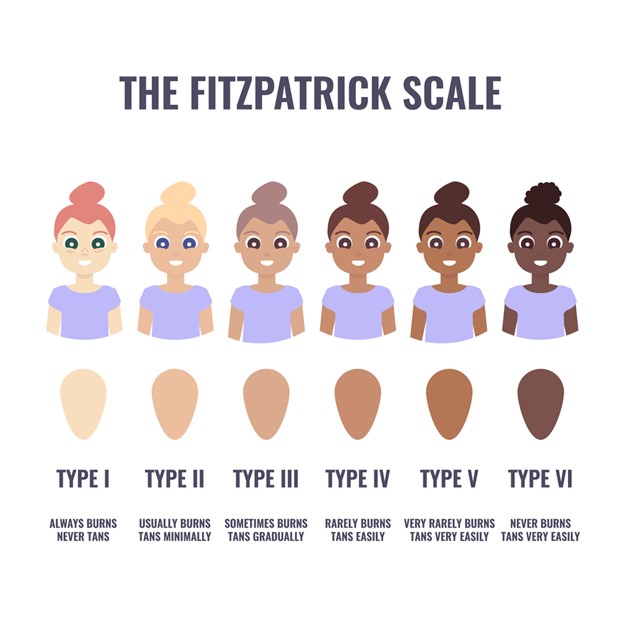Many people have never heard of the Fitzpatrick Scale for skin types. So, who was Fitzpatrick, and why is this information useful? The Fitzpatrick Scale is a practical classification for skin complexions that can help determine a person’s probability for tanning or sun burning when exposed to ultraviolet light. It’s helpful in assessing the risk for developing skin cancer from sun exposure. Physicians use the scale when determining appropriate doses of UV or laser therapy for skin treatments.
Background
The Fitzpatrick Scale was developed in 1975 by dermatologist Thomas B. Fitzpatrick. The scale is divided into six skin types, ranging from Type I skin that always sunburns to Type VI skin that doesn’t easily burn. A person’s classification is based on observable characteristics. However, the scale has limitations for people of color, as it does not account for skin color ranges for people with darker skin. The descriptions in the scale are somewhat subjective, making it harder for those with darker skin to classify their skin type or determine their risk for skin cancer.
Fitzpatrick Scale Classifications
The following are the classifications and characteristics of skin types based on the Fitzpatrick scale:
- Type I (Ivory) – Pale, porcelain, or ivory toned skin. Individuals typically have blonde or red hair with blue, green, or gray eyes. Very sensitive to UV exposure; skin always burns, peels, and never tans.
- Type II (Beige) – Fair or cream colored skin; may have beige undertones and freckles. Burns easily and often peels; tans with difficulty.
- Type III (Light brown) – Golden or light olive skin that sometimes burns but may tan gradually.
- Type IV (Medium brown) – Caramel colored skin that rarely burns and tans easily. Individuals usually have dark hair and eyes.
- Type V (Dark brown) – Bronze or rich brown skin and dark hair and eyes. Rarely sunburns and tans easily.
- Type VI (Very dark brown) – Deeply pigmented skin that almost never burns. Least sensitive to UV light.
Making Informed Decisions
Knowing your Fitzpatrick skin type helps when choosing skincare products and treatments. All individuals, regardless of skin type, should protect their skin from harmful UV exposure with sunscreen. Sun exposure increases the risk for skin cancer and also contributes to the development of fine lines and wrinkles. Damage from sun exposure leads to premature aging of the skin. Knowing your skin type may help you determine the appropriate amount of SPF protection needed in your sunscreen.
Knowing your Fitzpatrick skin type may help in choosing appropriate skin treatments. Individuals with darker skin (higher numbers on the Fitzpatrick Scale) should avoid skin treatments that use excessive heat or cause irritation. These individuals are at greater risk of developing hyperpigmentation. Skincare products that are harsh or irritating should also be avoided.
Next Steps
Dr. Cristina Keusch, Board Certified plastic surgeon at Boca Raton Plastic Surgery Center, is happy to answer questions about appropriate products and treatments for all skin types. Contact us today to schedule a consultation.




